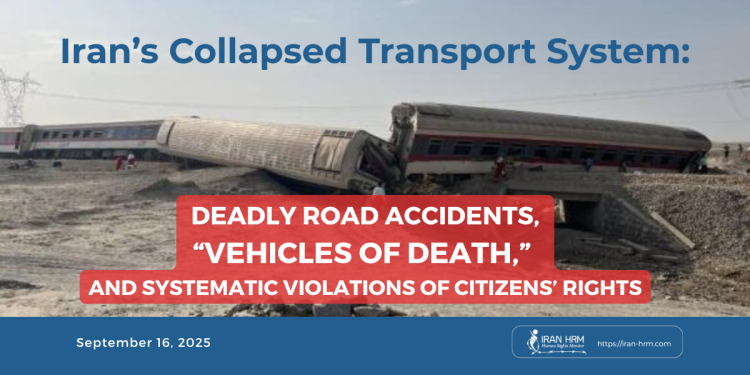On 16 September – with the start of European Mobility Week 2025, while the EU highlights sustainable and safe mobility, Iran under the mullahs’ regime faces a deepening transport crisis. Aging fleets, unsafe roads, substandard vehicles, and structural corruption together claim tens of thousands of lives every year.
According to Iran’s own official bodies (IRNA), between 17,000 and 20,000 people are killed and 250,000–400,000 injured annually in road accidents. The World Health Organization (WHO) WHO Data – Iran estimates the figure at around 21,000 annual deaths, ranking Iran 113th out of 175 countries worldwide for road traffic fatalities.
A Collapsed and Aging Fleet
The National Center for Air and Climate Change (Department of Environment) admits that over 86% of Iran’s public transport fleet has reached the end of its service life. (Source: IRNA) The Traffic Police (Rahvar) reports the figure at around 60%. (Source: ISNA)
According to Brigadier General Mohammad Bagher Salimi, Deputy for Operations of Iran’s Traffic Police, out of 41.5 million vehicles nationwide, 47% of cars and 91% of motorcycles are unsafe and obsolete; described by experts as “moving bombs.” (Source: Tasnim)
Shocking Statistics
- The daily newspaper Setareh Sobh, citing the National Crisis Management Organization (Setareh Sobh), reported that Iran loses 17,000 people annually, while 250,000 are injured and at least 25,000 permanently disabled.
- The Welfare Organization has confirmed that around 2,500 people suffer spinal cord injuries every year, more than 50% caused by road crashes.
- Brigadier General Kamel Hadianfar, Head of the Traffic Police, admitted that in the first nine months of 2021 alone, over 13,154 people died on Iran’s roads. (Tasnim)
- ISNA News Agency (ISNA) reported 45–50 deaths and more than 1,000 injuries every day.
- The Legal Medicine Organization announced that in the past five years, 91,144 people have lost their lives in road crashes. (IRNA)
- State media (IRNA) have admitted that in the past two decades, over 500,000 people have been killed and more than 4.5 million injured or disabled.
- The WHO (EMRO Study) reports that Iran’s road traffic fatality rate is 20.5 per 100,000 population, about 21,000 deaths annually.
- According to the Traffic Police Chief, the domestic car Pride alone accounts for 24% of all fatal accidents.
- Donya-e-Eqtesad quoted the Head of the National Emergency Organization estimating the economic losses at $14–30 billion annually — around 6–7% of Iran’s GDP.
The Three Factors: Human, Vehicle, Road
The Traffic Police attributes 82% of accidents to human error. (ISNA)
However, experts stress that unsafe vehicles and substandard roads are the real causes of fatalities:
- According to the Tehran Traffic Police, airbags in many domestic cars fail to deploy.
- Hadianfar admitted there are more than 5,200 accident-prone blackspots nationwide (IRNA).
- A former Minister of Roads conceded that 20–40% of arterial roads lack proper safety standards.
The Role of the IRGC and the Automobile Mafia
Parliamentary investigations have shown that the IRGC and security-linked institutions dominate the management of Iran Khodro and SAIPA. State-run media (Hamdel Daily) call this the “automobile mafia.”
Hamdel Daily reported that domestic carmakers are responsible for 86% of fatal and injurious accidents.
State outlets also admit that over 60% of spare parts are counterfeit and substandard. The IRGC’s Khatam al-Anbia controls major road construction projects, creating the lethal mix of unsafe vehicles and hazardous roads.
Human and Social Impact
- Regime parliamentarians admit almost no family in Iran has been spared losing someone in crashes.
- Victims are overwhelmingly under 50; the country’s active workforce.
- ISNA reported that daily around 200 families fall into extreme poverty after losing their breadwinners.
- The Welfare Organization estimates that rehabilitation for a spinal cord injury survivor costs at least 4.5 million tomans per month.
Legal Analysis
- Violation of the right to life under Article 6 of the ICCPR
- Violation of the right to safe movement under Article 12 of the ICCPR
- Breach of obligations under CEDAW, as women face heightened insecurity in public transport.
- Under Article 7 of the Rome Statute, deliberate neglect of a mass-fatality crisis that claims tens of thousands of lives annually may constitute a crime against humanity.
Conclusion and Call to Action
As Europe marks EUROPEANMOBILITYWEEK 2025 under the theme “Mobility for Everyone,” highlighting safe, accessible, and sustainable transport for all, Iran stands in stark contrast. While the world promotes car-free days, clean mobility, and inclusive transport, Iranians face lethal roads, collapsing fleets, and a transport sector run by the IRGC mafia—claiming over 20,000 lives each year.
This is not simply negligence; it is a systematic violation of the right to life and safety.
We urge the UN Human Rights Council (UNHRC) and international bodies to:
Launch an independent investigation into Iran’s catastrophic road safety crisis,
Hold the regime accountable for the IRGC’s role in systemic killings through unsafe vehicles and roads,
Apply pressure for urgent reforms to remove lethal vehicles from circulation and enforce safety standards.







